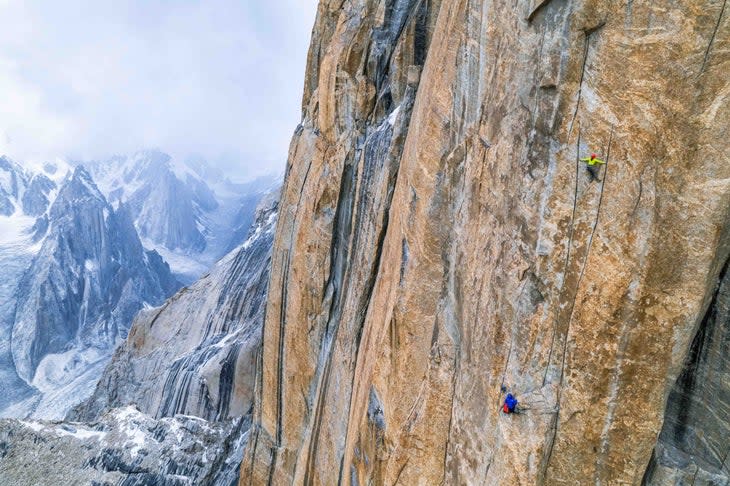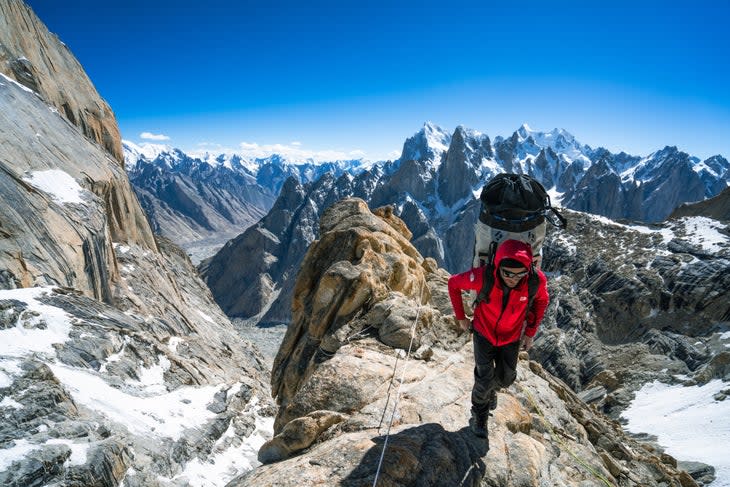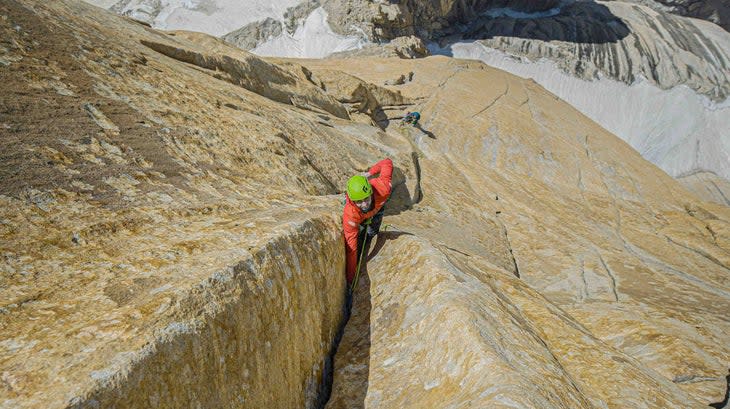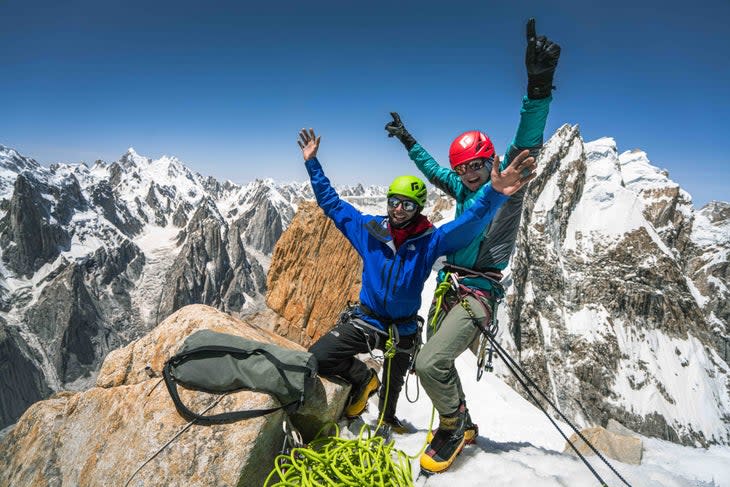Jacopo Larcher and Babsi Zangerl on Keeping the “Eternal Flame” Burning
This article originally appeared on Climbing
Eternal Flame is one of the world's hardest big-wall climbs. The 2,100-foot line harbors difficulties up to 7c+/5.13a at an elevation of over 20,000 feet, creating a challenging combination of nails-hard rock climbing, big-wall logistics, and high-alpine conditions.
This year, two parties made rare free ascents of the route on Pakistan’s Nameless Tower, put up by Wolfgang Gullich, Kurt Albert, Christof Stiegler, and Milan Sykora in 1989 at 5.12c A2, and first freed by Alex and Thomas Huber at 5.13a in 2009.
Edu Marin, accompanied by his brother and 70-year-old father, topped out July 20 after spending a grueling 28 days on the route, much of it stuck alone in sub-freezing conditions high on the wall. Only a few days later, Barbara "Babsi" Zangerl and Jacopo Larcher made their own free ascent, without a single fall and in one continuous onsight push, summiting July 23. They swapped leads for most of the route’s easier pitches, but each led the four hardest pitches, rated 5.12d to 5.13a.

Her motivation to attempt the historic climb stretched as far back as a decade, Zangerl told Climbing. "I remember I first saw a picture of the Trango Towers maybe ten years ago, back when I started sport climbing. Going there was a dream that felt so far away," she said, "but I knew it would be a real adventure to go on an expedition like that."
That dream finally came true in 2021, when she and longtime partner Larcher made an initial effort at Eternal Flame. Unfortunately, horrendous weather stymied most of their attempts at climbing, and the pair spent over three weeks stuck at base camp. "We were just unlucky," Larcher said. "We basically got to climb only one day on the first two pitches [5.4 and 5.11d]." These pitches, which they onsighted, were the only pitches the duo didn't bother to free during their successful climb this year.
Aside from the scant bit of climbing they did take down, the pair noted that they did learn a few things during last year's foray. Namely, that they'd need to arrive at Nameless Tower much earlier to have a viable weather window. This year they came in early July, instead of August. Again, however, they were forced to wait out over a week of bad weather. "It was frustrating, but it was good in the end," Larcher said. "It gave us time to acclimatize, to carry our gear up to the base of the wall."

Even that process was a bearish effort, with over 4,000 feet of elevation to gain between their basecamp and the start of the route. "Without a pack it's not too bad," said Larcher, "but having haul bags, it can be very tough." They dodged serious rockfall on several occasions, and were almost hit at one point, with rocks smashing less than three feet away from them. At another point, their tents were both destroyed by rockfall, though they luckily weren't inside at the time.
On July 18 weather cleared and Zangerl and Larcher finally began to climb, topping out the route six days later after a single, non-stop push. "Honestly, the plan at the beginning was just to swap leads on every pitch," Larcher said, "but then as we had more time and the weather held, everything went well, so we decided to [each free the cruxes on lead]."
Like Marin (who also spoke with Climbing), Zangerl and Larcher said the crux of the route was not so much the difficulty of the route, but everything else that goes along with sending a big wall at altitude. Simply reaching the base of the climb took around five hours, and the duo lapped the approach multiple times to ferry all their supplies and gear.
Also Read: Nathan Hadley Establishes The Rubbernecker: Steep 5.14- in Washington Alpine
In addition to rockfall, the team dodged severe bouts of altitude sickness as well. "I was not hungry, I couldn't sleep," Zangerl recounted. "I slept no more than three hours each night." In the beginning, the effects were debilitating. "But as soon as I started moving faster up the route, trying harder, the sickness got way better," she said. "But if I chilled, laid down, had a rest, I started feeling bad again."
Regarding the grade, Marin told Climbing he believed the crux pitch to be a stiff 5.13b, while Larcher and Zangerl said they agreed with the Hubers' proposed 5.13a. "I think that some of the easier pitches could be harder, but it really depends on the pitch," Zangerl said. "The [5.12a] traverse pitch felt pretty hard to us, compared to the first [5.12d]." The pair's experience and comfort with crack climbing was a major boon, as well. "Most of the pitches where we really had to jam weren't that hard," Larcher said. "We've crack climbed quite a bit so we felt comfortable in that style, but then some of the face climbing pitches [felt] harder."

Crack-climbing skills aside, they both made clear that their success was largely due to the good weather they experienced this time around, "To free climb [Eternal Flame] is to find good conditions," Larcher explained. "If it's too hot, the snow and ice melt and the pitches stay wet for almost the entire day. If it's too cold, you can't climb." "If there are just a few clouds or a bit of wind, it's so cold that you have no chance free climbing," Zangerl added.
Luckily this summer saw much warmer temperatures than the pair's expedition last year. In 2021 they recorded temperatures of -13 at 20,000 feet. This year temperatures were closer to 30 . The warmth made the route's lower pitches difficult, however, because by mid-morning everything below the Snow Ledge was soaking wet from the melted snow and ice.
The duo didn't have any hairy moments while climbing, but while jugging up to remove fixed lines they'd left for filming after the climb, Zangerl said the ropes were so frozen her jumars were unable to grip. "I couldn't remove the ice from the lines, and I was sliding down every time I [jugged up]," she said. She was forced to tie knots in the rope every few feet to stop her ascenders from sliding down. It took her over two hours to ascend less than 200 feet of line. "It wasn't scary," she said, "but very annoying, cold, windy, with lots of snow."
Despite the overlapping timeframe with their and Marin's ascents, Larcher and Zangerl said there was no competition between their parties. Marin was already on the wall by the time they arrived, and he didn't come down until he'd finished his ascent. They only came face-to-face with him on the route a day or two after he'd summited, but kept in touch with him via inReach for the whole time he was on the wall, and spent a lot of time with his father and brother at base camp.
"The route was already freed before [by the Hubers], so there was no stress or competition for us," Larcher said. "We knew that both us and Edu would both be going this year. It wasn't about getting it before one another, it was about getting it done for us in a style that we're proud of. Besides, he was already on the wall when we arrived, so it was clear that he would climb it first."
Looking forward, Zangerl and Larcher said they're inspired to do more alpine routes in a similar style. "We definitely want to go back to Pakistan, but don't have a specific goal," Zangerl said. "Although, I think I'm not made for the really high mountains," she added, laughing. "I'm not sure I can free climb higher than [20,500 feet]!"
Luckily for her, that's probably an unnecessary concern. There aren't many routes higher and harder than Eternal Flame.

Also read:
For exclusive access to all of our fitness, gear, adventure, and travel stories, plus discounts on trips, events, and gear, sign up for Outside+ today.


